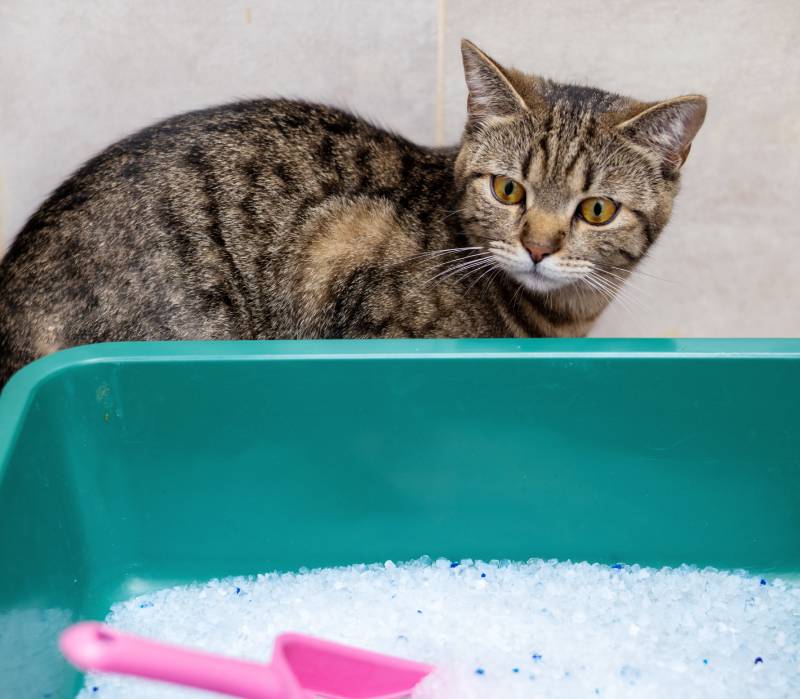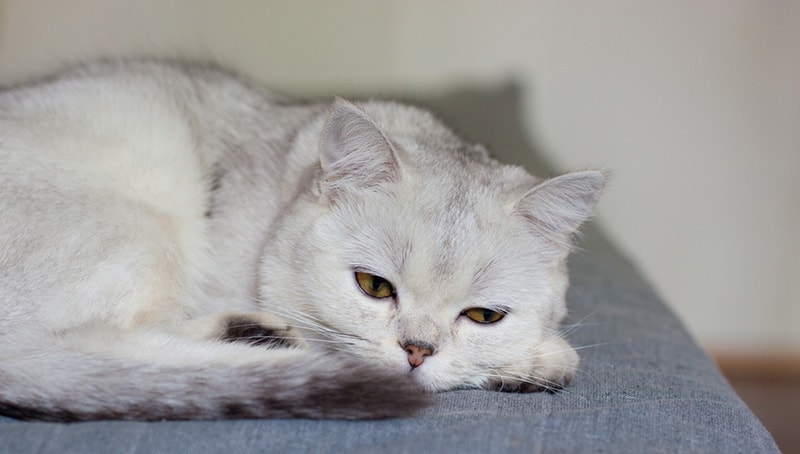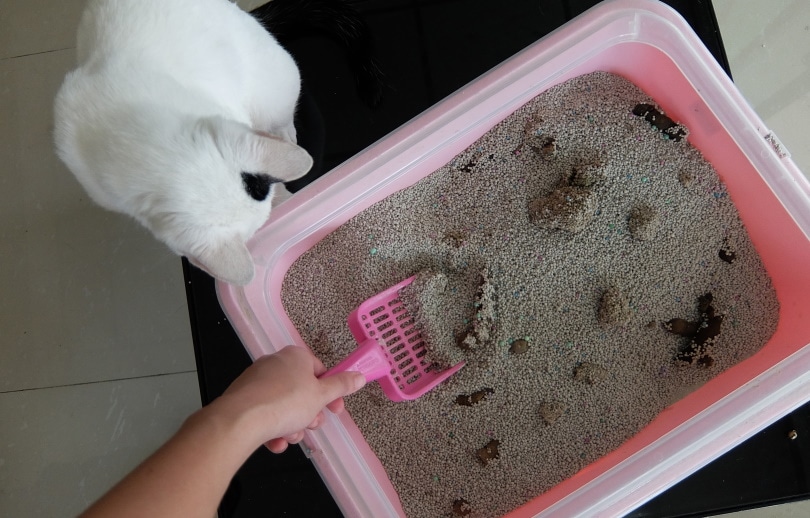
Litter attractants are added to cat litter to tempt cats, particularly those that are experiencing litter box issues, to spend time peeing and pooping in the litter box instead of elsewhere. Although research regarding the effectiveness of litter attractants is limited, litter attractants appear to work for some cats.
Before trying litter attractants, speak with your veterinarian. Litter box avoidance and other behavioral changes linked to urination and defecation often indicate that cats aren’t feeling well. If your cat isn’t urinating normally due to a health issue, such as an infection, illness, or stress around using the litter box, the attractant will not help.
If your cat gets the all-clear from the vet and there is no indication of a medical problem causing misuse of the litter box, a litter attractant may encourage them to use it again.

Research Results
In a 2019 study designed to evaluate the efficacy of one specific attractant, the cats urinated more often in the attractant-treated plant-based litter than in the untreated plant-based litter.1
The cats were familiar with clay-based litter, but the researchers were unsure if they had used plant-based litter. Therefore, they determined that using natural litter was a better material for the test because cats would not be biased by their experiences with clay products.
The study also uncovered that cats prefer to use clean litter boxes next to a wall rather than away from it. This is the only study focused on the effectiveness of litter attractants, but since it showed that most cats preferred the litter with an attractant, it might convince your healthy cat to use the bathroom in the box rather than your carpet.


What Are Litter Attractants?
Litter attractants are additives that make a cat’s litter box more appealing. Some products merely absorb odors and don’t have additional fragrances, while others use herbs like catnip to attract cats to the litter. You can also purchase litter that contains an attractant. Next, we’ll discuss each type in more detail.
Odor Absorbers
Cats prefer a clean litter tray over a dirty one, particularly when it comes to solid material. Removing feces and clumped litter is important when making a litter box more appealing, and unless the box is clean, the attractant won’t help.
Using odor-absorbing products can irritate some cats if they include strong fragrances, but you can find several formulas that only contain baking soda. Bicarbonate of soda is unlikely to bother your cat, and it will make the litter box more pleasant by reducing odors.

Sprays and Powders
Commercial sprays and powders are designed to attract cats and encourage them to associate positively with their litter boxes. Their ingredients vary, but we recommend using attractants with herbs like catnip. If the ingredients include chemical fragrances and additives, you can’t be sure they’re safe for your cat.
DIY Additives
Dried catnip can be sprinkled directly on the litter to attract your cat, or you can use a catnip spray on the sides of the litter box. Valerian and silvervine powders are also safe to add to the litter box.

Commercial Litters
You can purchase commercial litter with attractants already added. Several types are available, including clumping and non-clumping options and biodegradable choices made from walnut shells.
Unscented and scented products are available, but scented litter can sometimes be too much for cats with sensitive noses. Since catnip and other cat-safe herbs are inexpensive, buying regular, unscented litter and adding a natural attractant is more cost-effective than buying a more expensive formula with an attractant.

What Causes Litter Box Problems in Cats?
Litter box problems in cats are linked to various causes, including illness and stress. For instance, cats with mobility problems or joint issues have trouble entering and exiting litter boxes with high sides and may decide to go on the floor instead.
Cats with urinary tract problems often urinate in cool, smooth spots like bathtubs. Changes in litter box behavior can be a sign of stress or anxiety, and some cats suffer from stress-related cystitis. Other conditions leading to litter box issues include hyperthyroidism, kidney disease, and bladder stones.
Kidney disease and diabetes can make cats urinate more often, and if their owners don’t keep the litter boxes clean, the cats will find a more appealing area, such as the carpet.


Are There Ways to Encourage Cats to Return to the Litter Box?
Once your cat has been checked out by a veterinarian and received a clean bill of health, you can try one of our suggestions below to convince them to use the litter box.
It’s better to try them before using an attractant. If one solves the problem, you don’t have to spend money on herbs or commercial products.
Location
Most cats prefer to use the litter box in quiet areas that provide privacy, and older pets may have trouble navigating stairs or getting to litter boxes far away from their favorite hangouts. To make it easier for your cat to access their bathroom, it’s best to have at least one litter box on every level of your house.
Place the box in a room without loud appliances and far away from your cat’s food and water bowls. Cats dislike using the bathroom near their food.

Litter box number
The rule of thumb for litter boxes is to have one per cat, plus one extra. This helps reduce any competition for resources between cats and, therefore, reduces stress. Resource guarding is usually associated with food or toys but can include litter boxes.
If you frequently see urine or feces on the floor and have multiple felines, one of your cats may be bullying another and preventing them from entering the box. If you add additional boxes and space them out around your home, your bullied cat may feel more comfortable and use the litter box.
Cleanliness
Cats have powerful noses and high standards when it comes to litter box cleanliness. The litter should be scooped daily, but particularly sensitive cats appreciate twice-daily scooping. The boxes must also be cleaned with soap and water every week, especially if you have more than one cat.

Litter Box Design and Litter Choice
Some cats like large, wide, open litter boxes, and others prefer enclosed units that provide privacy. Cats with mobility issues have difficulty getting into top-entry boxes with high sides and need models with low-entry points.
Some cats also have strong preferences regarding the litter’s texture; grainy sand-like products are popular, but your cat may prefer crystal or recycled paper litter. Setting up a few litter boxes with different litter substrates is a simple way to discover if your cat has a litter preference.
Stress Reduction
Cats that are anxious or stressed can display several signs. Some stressed cats withdraw and start sleeping more, but excessive grooming and litter box issues are common. If they’re displaying these signs, your veterinarian should examine your cat, and if the stress is a behavioral problem, they can provide advice to reduce it.
However, you can also make your home more cat-friendly if the problem seems to be related to the environment. Monitor the dynamic between your cats if you have more than one. Do they sleep and groom each other? If so, the other cat is unlikely to be causing the stress.
If they don’t, one of your cats may be stressing out the other. To reduce their stress, ensure you have multiple feeding, drinking, sleeping, and toileting areas available so that the cats can avoid one another if they prefer to. You can also provide each cat with separate toys, scratching posts, and cat trees to reduce resource guarding.

Combating Odor
Even if you keep a clean and tidy litterbox, you probably still find yourself with cat odors and stains around the house – but with the Hepper Advanced Bio-Enzyme Pet Stain & Odor Eliminator Spray & Litter Deodorizer, you can combat even the very worst pet stains and litter box smells!
At Pet Keen, we’ve admired Hepper for many years, and decided to take a controlling ownership interest so that we could benefit from the outstanding products of this cool cat company!

Conclusion
Litter attractants can convince cats to urinate and defecate in the litter box instead of on the floor, but you may need to make a few changes in your home before using them. Cats avoid litter boxes or use the bathroom outside of them for several reasons, including stress and illness, and it’s essential to have your cat checked out by a veterinarian if you notice any changes in their bathroom habits
Cats may avoid using the litter box because of its location, shape, or even the type of litter it contains. Evidence suggests that cats may prefer to pee in litter treated by attractants. However, there’s also evidence that keeping the litter box clean, putting litter boxes in convenient places, and ensuring cats have a type of litter that pleases their paws and noses can also help.
Featured Image Credit: Alexandra Morosanu, Shutterstock


